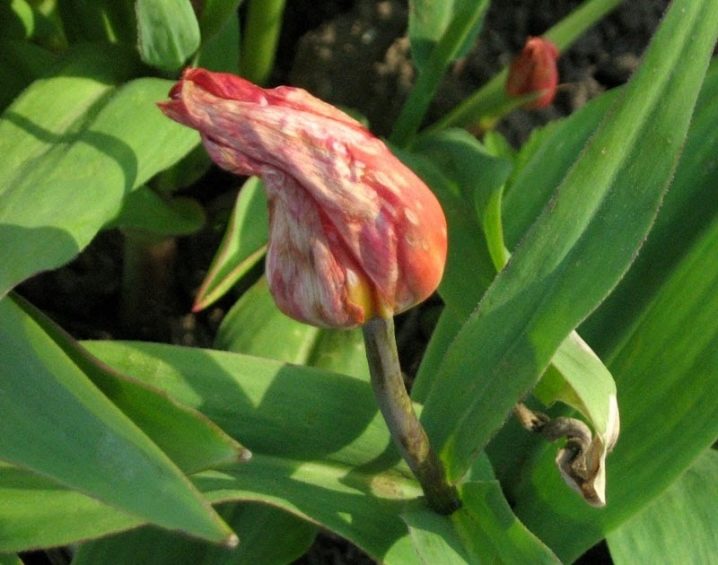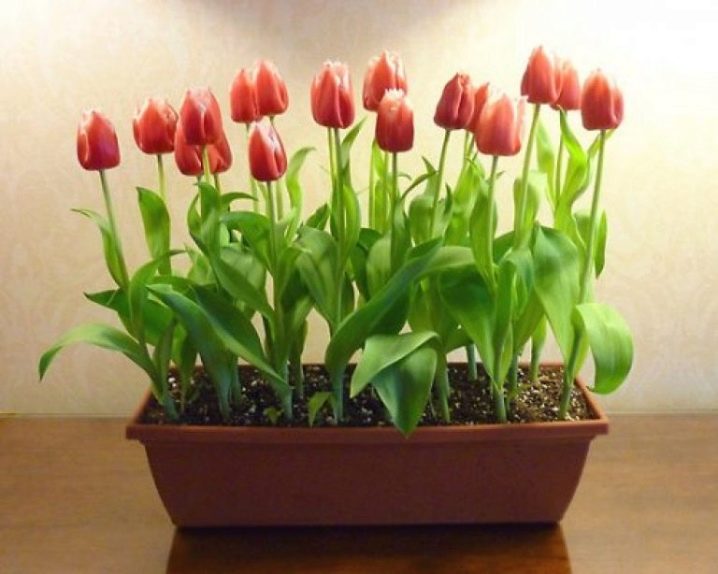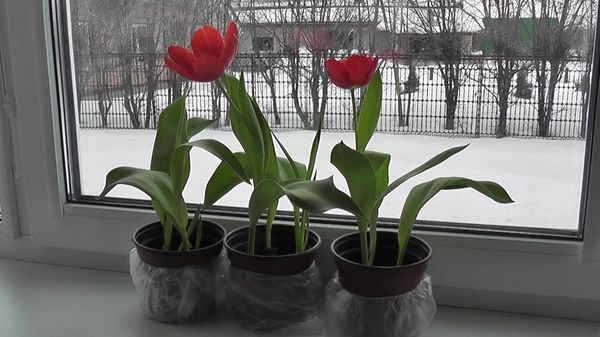Diseases and pests
The most dangerous mushrooms for tulips are mushrooms. They penetrate the flower bulb itself and destroy it. The cause of the appearance of fungal diseases is high humidity. It is possible to dry the bulb incorrectly without observing the temperature regime, then it will already initially be sick. Or you can plant a bulb and take care of it incorrectly, then inflammatory processes will begin to appear in the ground.
Due to the fungus, the flower becomes weak, lethargic, may release an arrow and not bloom. The most dangerous fungal infections are gray rot, white rot, typhulosis, root rot, fusarium.

Viral diseases are also dangerous for flowers. Unfortunately, there is currently no cure for viral infections such as variegation and August disease. In the case of variegation, spots and stripes on the petals are observed. Previously it was believed that this is a new variety of tulips and gardeners even tried to breed such flowers in large numbers, however, today it is reliably known that petals affected by the virus acquire a different color. It can be brought in by birds, insects, including those living in the ground, and even by the person himself when cutting a flower (in the event that, for example, if the juice from a sick tulip gets on the stem or petals of a healthy one).
August disease manifests itself in the form of an ugly curvature of the stem, flower leaves. The virus affects the growth and development of tulips. Both the bulb itself (rotting will be visible on it), and the stems and leaves (light spots will be visible on them) can be affected. This virus is transmitted from the weeds on which it constantly lives. Unfortunately, the affected bulbs cannot be cured and must be destroyed.

Bacteria and microorganisms, as well as insects that live in the ground, are no less dangerous for tulips. Depending on what symptoms the tulip has, appropriate treatment is undertaken. This can be either spraying or watering the plant with the necessary solutions. The addition of ash, magnesium, sodium may also be needed.
The disease weakens the flowers, disrupts the cycle of his life. Even by releasing an arrow, a tulip may not bloom.
If the flower grew strong, and yellowness began to appear on the leaves, pay attention to whether you have changed the location of the plant, whether it is standing in a draft. Be sure to check if there is enough sunlight for the flower, if the lighting is normal for it.
This is the first reason for yellow and weak leaves, provided that the tulip has grown strong and healthy before.
It is important to establish the cause of the disease as early as possible and eliminate it. Otherwise, the flowering of these beautiful flowers cannot be expected.
Indoor flowers feel when they are lovingly grown, when they are properly cared for. They will gratefully respond to your efforts with beautiful, fresh, bright and large flowers.

For information on how to grow tulips at home by March 8, see the next video.
Possible mistakes when forcing tulips at home

To get beautiful high-quality flowers by March 8, it is necessary to avoid mistakes that can interfere with successful forcing.
Pay attention to the following points:
- It is better not to choose too whimsical varieties, or tulips with an unsuitable flowering period. Consider these nuances when buying bulbs. The most suitable: the varietal group of tulips "Triumph" and "Darwin's hybrids".
- Planting bulbs that are too small will result in no buds and only leaves.
- In the event that the soil is too warm during the cooling period, the bulbs can rot. That is why it is better to keep them in the refrigerator.
- If the soil moisture is insufficient, the rooting of the bulbs will be difficult.
- Violation of the temperature regime during storage of the bulbs upward will lead to the fact that the flowers will be deformed.
- Keep fresh fruit away from the bulbs when storing them in the refrigerator. The release of ethylene will accelerate the germination of tulips, and the timing of bud appearance will shift.
- If the bulbs are overexposed in the refrigerator, the flower stalks may appear curved; if the planting material is taken out of the cold ahead of time, the flower stalks will grow too short.
- When grown on a windowsill, did the flowers droop? It is necessary to lower the air temperature. The same should be done if the buds look "papery".
It is difficult for beginners to foresee everything, they may well forget about some important point. Therefore, it is better to re-read information on caring for bulbs during cultivation from time to time in order to do everything right.
Tulips have faded, what's next?

After the flowers have been cut or bloomed right in the pots, the question arises, what to do with the remaining bulbs? It is quite possible to plant them later in open ground to grow outdoors, but first you need to let the plants complete their development cycle. If tulips have bloomed in your pot, cut off the wilted stalks.
After flowering, the plant needs to continue to water for about a month. It is desirable that during this period the temperature does not exceed 20 degrees. After a month, the bulbs are removed from the ground and dried, and then kept in a cool room for about 45 days. After rest, the planting material can be planted on a street flower bed.
If late-flowering varieties were distilled, then the shelf life must be extended so that the bulbs ripen. Sort the planting material before planting. Bulbs that are severely affected by disease and rot will have to be thrown away. If the lesions are small, they are cut off to healthy tissue and this place is treated with special preparations.
How to grow tulips at home by March 8: video
Try to give yourself a spring mood and get blooming tulips by March 8 at home. Those who have been forcing bulbous crops claim that this is a very exciting activity. And the joy of the appearance of bright spring buds will be a real reward for your work.
How to grow tulips at home
When tulips are to be distilled by March 8, in October the florist must prepare:
- loose light substrate, for example a mixture of sand and sawdust, peat, perlite and garden soil, in which the bulb will take root well and quickly;
- containers with perforated bottom to drain excess moisture or pots with drainage holes;
- lamps for phyto-illumination, with which you can extend the daylight hours, prevent the sprouts from stretching and weakening.
The tulip bulbs selected for forcing are cleaned of hard brown scales before being transferred to the ground, inspected and sorted again. Before growing tulips at home, planting material is treated with a warm pink solution of potassium permanganate, it will reduce the risk of rot and fungal diseases.
During forcing, bulbous plants actively consume the forces accumulated during the dormant period, so they do not need a lot of space and especially nutritious soil. For industrial plantings, up to 350 plants can fall on a square meter. At home, tulips are planted at intervals of 5-10 mm, lightly pressing into the substrate. When all the bulbs are in their places, the soil is filled up, and the containers are watered abundantly. If necessary, add soil after watering.
The tulips are then transferred to a room with a temperature of 5–9 ° C and an air humidity of 75–80%.Here the plants have to take root, and when the first shoots appear, the temperature is further lowered to 2–4 ° C.
In such conditions, tulips are kept until 3 weeks remain for the moment of their planned flowering. By this time, foliage with a height of about 6 cm rises above the soil, and the plants need more heat and light. The air warming level is changed gradually, bringing it to 16-18 ° C in 3-5 days. So that the sprouts are strong and the peduncles are strong, they turn on the lamps daily above the containers, extending the daylight hours from 3 to 5 hours. Watering tulips, as before, is carried out at the first signs of drying out of the soil. Plants are fed daily with ammonium nitrate or other mixtures containing nitrogen and phosphorus.
If all the conditions are met, soon the ends of the buds that appear will begin to stain. At this point, it is advisable to lower the temperature by 3-5 ° C, which will somewhat delay the opening of corollas and prolong their flowering.


